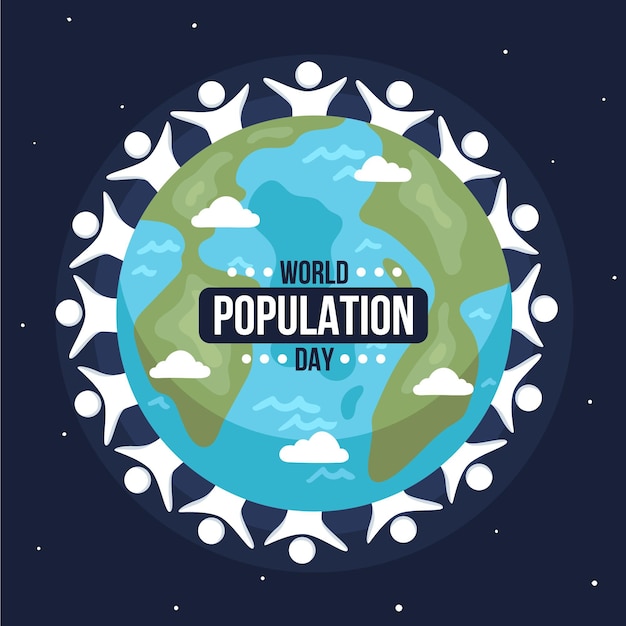World Population Day: Addressing Challenges and Shaping a Sustainable Future
World Population Day, observed on July 11th every year, serves as a reminder of the pressing global challenges associated with population growth and its impact on various aspects of human development. This day was established by the United Nations to raise awareness about population issues and advocate for reproductive health and rights. The world’s population continues to grow rapidly, presenting both opportunities and challenges. This essay delves into the significance of World Population Day, highlights the key challenges, and explores the necessary steps to shape a sustainable future for our planet.

I. The Significance of World Population Day:
World Population Day plays a crucial role in drawing attention to the various dimensions of population growth and its implications. It serves as a platform for governments, organizations, and individuals to come together and discuss strategies for sustainable development. The day emphasizes the importance of understanding population dynamics, promoting reproductive health, and empowering individuals to make informed decisions about their reproductive choices.
II. Challenges Associated with Population Growth:
a) Rapid Urbanization and Infrastructure Strain:
As the population increases, urban areas face immense pressure to accommodate the growing number of residents. Rapid urbanization often leads to inadequate infrastructure, including housing, transportation, sanitation, and healthcare systems. World Population Day serves as a reminder of the need to plan and invest in sustainable urban development to provide a better quality of life for all.
b) Environmental Impacts:
Population growth exerts a significant strain on natural resources and ecosystems. Increased consumption patterns and resource demands contribute to deforestation, depletion of freshwater sources, pollution, and climate change. On World Population Day, it is imperative to promote sustainable consumption and production patterns to mitigate these environmental challenges.
c) Health and Well-being:
Population growth poses challenges to healthcare systems, particularly in developing countries. Ensuring access to quality healthcare, family planning services, and addressing maternal and child health issues become crucial concerns. World Population Day encourages investment in healthcare infrastructure, training healthcare professionals, and improving access to essential services.
d) Food Security:
With a growing global population, ensuring food security becomes paramount. Sustainable agricultural practices, promoting small-scale farming, improving access to technology, and reducing food waste are critical to meeting the nutritional needs of an expanding population. World Population Day highlights the importance of sustainable food systems and the elimination of hunger.
III. Promoting Reproductive Health and Rights:
World Population Day serves as a platform to advocate for reproductive health and rights for all individuals, irrespective of gender, age, or socioeconomic status. It calls for comprehensive sexuality education, access to family planning services, maternal and child health care, and the empowerment of women. By ensuring these rights, societies can address the challenges associated with population growth and promote individual well-being.
IV. Education and Empowerment:
Investing in education, particularly girls’ education, is instrumental in shaping a sustainable future. Educated individuals are more likely to make informed choices about their reproductive health, participate in the workforce, and contribute to the socio-economic development of their communities. World Population Day highlights the need to prioritize education as a means of empowering individuals and fostering sustainable development.
V. Engaging Youth and Civil Society:
World Population Day encourages the active participation of youth and civil society in addressing population-related challenges. Engaging young people in discussions and decision-making processes empowers them to contribute ideas, innovations, and solutions. It fosters a sense of ownership and responsibility, enabling the next generation to play a significant role in shaping a sustainable future.
VI. Collaboration and Partnerships:
Addressing the complex challenges posed by population growth requires collaborative efforts among governments, international organizations, civil society, and the private sector. World Population Day brings together various stakeholders to share knowledge, best practices, and resources. Collaborative partnerships enhance the effectiveness of interventions and promote a holistic approach to sustainable development.
Conclusion:
World Population Day serves as a timely reminder of the challenges and opportunities associated with population growth. By focusing on reproductive health and rights, sustainable development, education, and collaboration, societies can address these challenges effectively. This day provides an opportunity for individuals, communities, and organizations to come together, advocate for change, and shape a sustainable future for generations to come. Embracing the principles of equity, empowerment, and environmental stewardship will pave the way for a world where population growth and sustainable development go hand in hand.

1 thought on “Essay on World Population Day | TALK WITH SHIVI”